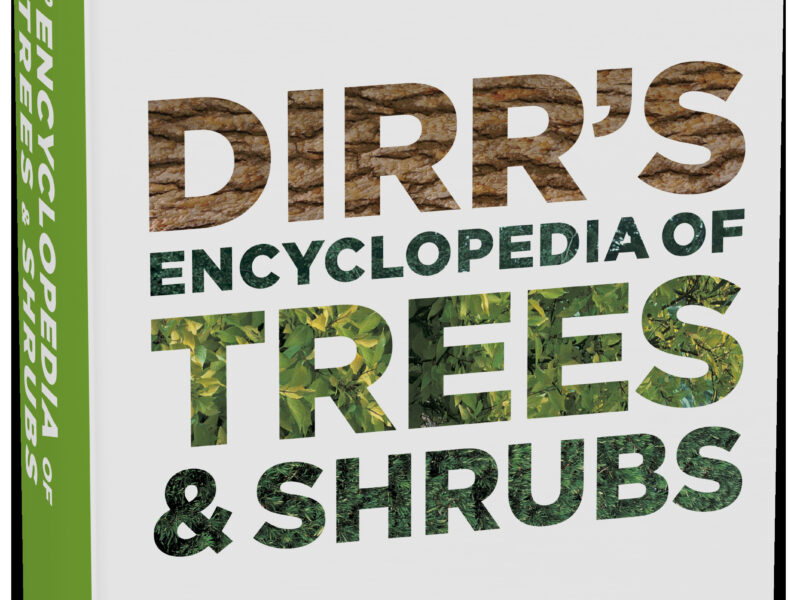

Don’t pay attention to the cold and threat of snow. The growing season is just weeks away, and there’s still an opportunity to put your dreams of flowers and vegetables aside for a short time and switch your attention to trees and shrubs. These are the essential backbones of our landscapes, and if you’ve bought a house or property chances are trees and shrubs came with the deal.
This week, two books that will help you look at myriad choices in the wonderful terrestrial world and how to prune them as well as selecting the ones that can be the right choices for your piece of paradise or paradise to be.
My first selection is a book that every beginning gardener to experienced gardener should have as a reference. The book is Steven Bradley’s “Pruning Simplified” (Timber Press, $20 or less and worth every penny). First released back in 2005, it’s now in its second edition. And no, the fact that it first came out 18 years ago is of little to no consequence as the basics of pruning haven’t changed much at all.
Pruning is as much an art as it is a science. However, if you don’t understand the basic science of pruning and you try your luck at the art part first, you and your tree are doomed. This book covers both.
There was one clearly obvious reason why I know I had to take a closer look at this book. On the bottom of the cover is a picture of a right hand firmly gripping a Felco #2 pruner. A very good sign since I’ve always thought the Felco #2 was the best general hand pruner available.
This paperback book is a step-by-step guide to pruning. The author concentrates on 50 varieties of trees and shrubs that are pretty much our basic 50. You can learn from the diagrams and descriptions how to handle pruning these plants, and the information that you’ll glean is easily transferable to just about all our trees. Bradley covers the basic pruning techniques, the tools to use and most importantly, not just how to prune but the all important when to prune. The “when” probably being as vexing a dilemma for new gardeners as is the “how.”
The book is organized in a logical sequence of initial instructions (including a page on “how to use this book”) followed by an alphabetical tour of the 50 candidates from Abelia through the woody vine that gets everyone stumped, Wisteria. There’s a color picture of each tree or shrub to help with identification. The text for each tree follows the same format which includes formative pruning (the early years), followed by routine pruning for the following years and then remedial pruning which covers caring for a maturing tree or shrub that may need corrective or remedial work.
While there’s nothing quite like a live and in-person pruning workshop, Bradley uses great color diagrams with consistent notations throughout the book that show not just where to make critical cuts but how and what to expect once the cuts are made. Each set of instructions also includes trees that can be pruned in a similar fashion making the information valuable for hundreds more plants that aren’t covered in detail.
Also included are vines such as Clematis, which, improperly pruned, will result in no flowers at all. One question I had was how the author would cover something like fastigiate, or columnar, trees and shrubs, and I found nearly all the information needed in a “Special Features” section that includes standards, conifers, hedges (yes, Virginia, there are hedges other than privet), climbers, and specialized pruning. And yes, he does have a section on roses, hurray. There’s a whole section on renovation pruning as well.
In a section toward the end there’s a fascinating number of pages on specialized pruning that includes nicking and notching (new to me), pollarding, coppicing, pleaching, festooning and more. This is followed by charts that include when to prune what, what not to prune and about 20 suitable hedge plants if you want to rebel against the privet world. This is followed by a detailed glossary and an index.
Got questions about when and how to prune that hydrangea? Many of the answers are in this book, but since it was originally published before the flooding of the market with new hydrangea varieties you may also want to take a look at this helpful video: youtube.com/watch?v=Z6STEztMaAQ
Bottom line, for $20 you just can’t go wrong with this wonderful guide. And while it can be helpful in your year-round landscape work you might find it very helpful while it’s still cold outside and perfect pruning conditions for many but not all plants.
My second book recommendation has been around for over a decade, but it’s now a downright bargain and should be in every serious gardener’s library. This is Michael Dirr’s “Encyclopedia of Trees and Shrubs” (Timber Press, hardcover and now just $40 and over 5 lbs.). Just shy of 1,000 pages with over 3,500 pictures and “indispensable lists,” this book has to be up there with “Hortus Third,” Allan Armitage’s “Herbaceous Perennial Plants,” and “Tropica: Color Cyclopedia of Exotic Plants and Trees” by Alfred Byrd Graf.
Dirr, like Armitage, was on the faculty of the University of Georgia in Athens, and they have certainly been the dynamic duo of perennials and trees. As a horticulturist soaking up all the information I could find 30 years ago, this is the type of treasure that I would have gladly spent my money on and then squirreled it away for a long winter read. But then I did the same with “Hortus Third,” which was much more technical, twice as heavy and three times more expensive.
So, how to use this book? First and foremost, you probably won’t read it cover to cover, though you should. It’s a reference, and the type of book you’d go to if you wanted to know more about a tree or shrub you’d seen in a nursery or garden center or on a garden tour. The information is straightforward and just a bit (but not too much) technical but lacking is information on diseases and insects as well as other threats to each species.
Dirr essentially paints a technical picture of each tree so you know what to expect in terms of size, leaf color and varietal idiosyncrasies including information on flowers that may be notable, bark characteristics as well as fruits that may be present. It’s the last 60 or so pages that may be a good starting point. It’s in this last section of the book that there is a compendium of specific characteristics or purposes for various trees and shrubs. The first section is based on color as it relates to the flowers including “stripes and blotches” with each variety assigned to a color group. The next section is on flowering sequence and when you might expect each species to flower or show color based broadly on the season including all four seasons. Next is a section on flower fragrance though there is no description of the scent, only that it exists.
The lists then move on to “fruit” and what color the fruits are but not when they are at peak color. Next is an extensive list of trees and shrubs with fall color and is divided into groupings of yellow, orange, red, purple, bronze and yellow-green. Great information when you need to consider how the foliage fits into an overall design or concept.
He then moves on to a listing of shade tolerant trees and then an all-important section on salt tolerance, which is critical for those planting near highways (road salt) and the oceans and bays. Consider also that depending on where you live salt may also be an issue in groundwater near the oceans and bays. Additional sections cover moist soil tolerance, dry soil tolerance (also critical on the East End), hedging material, evergreens for specimens, groupings, screens and groves, weeping or columnar habits and lastly vines for flowers, fruits and fall color. There is also a common name and botanical name cross index.
All in all, a magnificent book and one that I think you’ll find yourself going back to over and over for years to come. Dirr has had a lasting influence on horticulture and has personally taught more than a handful of East End nursery center owners, landscape architects and horticulturists who got their horticulture training at UGA in Athens in the 1970s up to 2003. For a while it was common to go to SUNY in Farmingdale and get a two-year horticulture degree then transfer to UGA and complete a four-year degree in horticulture. You may even find you have a tree or shrub that Dirr developed that’s living right on your little piece of heaven. Keep growing.
 More Posts from Andrew Messinger
More Posts from Andrew Messinger